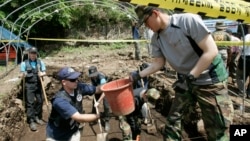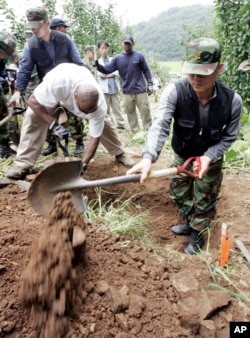“No man left behind.”
With that phrase, a recovery team leader identifies an excavation spot and splits it into grids. Whether the weather be bitingly cold or blisteringly hot, excavators filter the soil from the grids through quarter-inch wire screens, eyes alert for any sign of human remains.
For decades, the Central Identification Laboratory in Hawaii (CILHI) has sent search and recovery teams worldwide to retrieve remains of American servicemen fallen in battle, preserving a tradition that goes back to classical Greek mythology.
Although efforts to recover soldiers from World War II, the Korean War, the Vietnam War and other conflicts are ongoing, no CILHI team has visited North Korea since May 2005, according to the Defense POW/MIA Accounting Agency. Before that, 33 joint recovery operations (JROs) were conducted on North Korean territory between July 1996 and May 2005, when then-President George W. Bush halted the operation because of safety concerns.
Following last month’s Singapore Summit between U.S. President Donald Trump and North Korean leader Kim Jong Un, however, it appears likely that U.S. teams will once more be permitted to visit the reclusive nation and search for some of the 5,300 servicemen still unaccounted for there.
If so, the move will bring a large measure of satisfaction to Frank Metersky, a Korean War veteran from the 52nd Battalion, 5th Marine Regiment, who has been working for more than 30 years to get a full accounting of all those who never came home.
“In 1990 I started meeting with the North Korean representatives in New York to get them to agree to allow U.S. personnel go into North Korea to recover remains,” the 85-year-old veteran said. “I kept telling them. … It’s a very positive way to do it with a humanitarian context and wouldn’t cost them anything.”
The first search and recovery team in 1996 consisted of eight CILHI experts along with State Department North Korea affairs officer C. Kenneth Quinones, now retired, and then Army Lt. Col. Martin Wisda. Quinones and Wisda liaised with the CILHI search team, the North Korean Ministry of Foreign Affairs (MFA) and the U.S. government.
The search team members were accompanied at all times by North Korean military personnel and required to sleep in tents at the worksites, while the liaison teams had to return to Pyongyang each evening. Some North Koreans laborers were made available to help with digging, shifting dirt and moving equipment. A senior North Korean official was on site at all times.
“Daily, we rode in Jeep Cherokees which I had purchased in China and had flown into Pyongyang, and those were driven by a North Korean driver up to the worksite,” Quinones recalled. “We would spend the day there, provide the Americans bread — whatever fresh food we could purchase in Pyongyang — and then late in the afternoon we were required to return to Pyongyang.”
The July 1996 JRO was the only operation conducted that year.
“Initially, the [search and recovery team] was only allowed to work in the Unsan area,” Quinones said. “The North Koreans were extremely suspicious we were sending American soldiers as spies. … Everything was negotiated in detail.”
Information provided by local residents was often crucial.
“The most help came from North Korean farmers who had helped bury soldiers after the battle,” Quinones said. “That’s how we were able to locate precise locations of bodies. … [The farmers] turned out to be quite friendly.”
The team found the first identified remains, those of Army Corporal Lawrence LeBoeuf, with the help of a farmer, who, as a teenager had helped his father bury an American.
“That soldier’s blond hair was still there,” Quinones said. “His uniform, his dog tag, his wallet were there so we could very quickly identify him as an American soldier.”
After 2001, North Korea allowed two CILHI teams to work simultaneously at separate locations. Searches expanded from the northwestern region to the northeast, including an area east of the Chosin (Changjin) Reservoir.
Many of the lost soldiers whom the United States hopes to recover died in that area, said Karl Jenkins, 89, a Korean War veteran and former Marines logistics chief who spoke to VOA during a visit to the Korean War Veterans Memorial in Washington.
“We were taking quite a few casualties, and the ability to retrieve casualties was severely limited,” he said.
Jenkins and his grandson, Carl Henderson, were in the city courtesy of the Utah Honor Flight (UTF), part of a nonprofit organization that brings veterans to Washington to visit war memorials in the nation’s capital.
At the conclusion of each recovery operation from 1996 to 1999, the remains were delivered in coffins to Panmunjom, the border village where the Korean Armistice agreement was signed, and turned over to the United Nations Command for transfer to the CILHI. After 1999, the remains were flown directly from Pyongyang to Hawaii for identification.
Why does the drive to repatriate remain for decades?
“I think that those families just deserve to have everything that they can obtain — their honored ancestors that were buried there,” said Korean War veteran Serge Woodruff, 89, who was stationed during the Korean War with the 109th Regional Intelligence Corp in Philadelphia. He was also with the UTF along his daughter, Amy Woodruff.
“It must be remembered that [soldiers] find themselves in battle positions because they are serving their countries,” said Mike Sledge, the author of Soldier Dead. “The cause for which they are sent to fight must be a just and vital one. Recovering the remains of our fallen measures the political and human cost.”
Sledge likens this to a “moral reckoning.”
“It puts it out there for us to say, was this worth it? Was the reason good?” he said.
For Metersky and other vets, recovery is personal.
“I just hope it becomes a reality,” Metersky said. “That the families, the 5,300 remains get fully recovered.”










